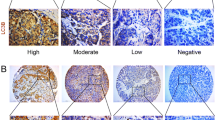Abstract
Purpose
Lysosomal protein transmembrane 4 beta-35 (LAPTM4B-35) is a tetra-transmembrane glycoprotein that is abundantly localized on membrane-bound organelles including endosomes and lysosomes, and promotes cell proliferation and tumorigenesis through regulation of cell cycle and signaling pathways. The aim of the present study is to determine the potential clinical implications of LAPTM4B-35 expression in hepatocellular carcinoma (HCC).
Methods
Immunohistochemistry assay was used to determine the expression of LAPTM4B-35 protein in normal and HCC tissues from 71 patients. The correlations of LAPTM4B-35 expression with clinicopathological parameters, including gender, age, background liver, viral status, tumor size, portal vein invasion, histopathological differentiation, serum AFP level, TNM staging and recurrence of HCC were assessed by Chi-squared test. Patient survival and their differences were determined by Kaplan–Meier method and log-rank test. Cox regression (Proportional hazard model) was adopted for multivariate analysis of prognostic factors.
Results
LAPTM4B-35 immunoreactivity was negative or low in normal liver tissues, but high in HCC tissues (51/71, 71.8%). The overexpression of LAPTM4B-35 was significantly associated with recurrence, TNM staging and portal vein invasion of HCC. Patients with high LAPTM4B-35 expression had significantly poorer overall survival (OS) and disease-free survival (DFS) (both P < 0.001) when compared with patients with the low expression of LAPTM4B-35. On multivariate analysis, LAPTM4B-35 expression was found to be an independent prognostic factor for OS and DFS (P = 0.018 and P = 0.001, respectively).
Conclusion
LAPTM4B-35 expression showed a strong association with the potencies of recurrence and metastasis and progression of HCC, and that may be applied as a novel marker for the prediction of recurrence and metastasis potency of HCC, and helpful for improving the diagnosis, prognosis and treatment of HCC.


Similar content being viewed by others
References
Bellacosa A, Testa JR, Staal SP, Tsichlis PN (1991) A retroviral oncogene, akt, encoding a serine-threonine kinase containing an SH2-like region. Science 254(5029):274–277
Bosch FX, Ribes J, Cleries R, Diaz M (2005) Epidemiology of hepatocellular carcinoma. Clin Liver Dis 9(2):v191–v211
Cabrita MA, Hobman TC, Hogue DL, King KM, Cass CE (1999) Mouse transporter protein, a membrane protein that regulates cellular multidrug resistance, is localized to lysosomes. Cancer Res 59(19):4890–4897
Datta SR, Brunet A, Greenberg ME (1999) Cellular survival: a play in three akts. Genes Dev 13(22):2905–2927
Farazi PA, Depinho RA (2006) Hepatocellular carcinoma pathogenesis: from genes to environment. Nat Rev Cancer 6(9):674–687
He J, Shao G, Zhou R (2003) Effects of the novel gene, LAPTM4B, highly expression in hepatocellular carcinoma on cell proliferation and tumorigenesis of NIH3T3 cells. Beijing Da Xue Xue Bao 35(4):348–352
Hogue DL, Kerby L, Ling V (1999) A mammalian lysosomal membrane protein confers multidrug resistance upon expression in Saccharomyces cerevisiae. J Biol Chem 274(18):12877–12882
Huang X, Ji G, Wu Y, Wan B, Yu L (2008) LAMA4, highly expressed in human hepatocellular carcinoma from Chinese patients, is a novel marker of tumor invasion and metastasis. J Cancer Res Clin Oncol 134(6):705–714
Isokawa O, Suda T, Aoyagi Y, Kawai H, Yokota T, Takahashi T, Tsukada K, Shimizu T, Mori S, Abe Y, Suzuki Y, Nomoto M, Mita Y, Yanagi M, Igarashi H, Asakura H (1999) Reduction of telomeric repeats as a possible predictor for development of hepatocellular carcinoma: convenient evaluation by slot-blot analysis. Hepatology 30(2):408–412
Kaibori M, Ishizaki M, Saito T, Matsui K, Kwon AH, Kamiyama Y (2009) Risk factors and outcome of early recurrence after resection of small hepatocellular carcinomas. Am J Surg 198:39–45
Kamiyama T, Nakanishi K, Yokoo H, Kamachi H, Tahara M, Suzuki T, Shimamura T, Furukawa H, Matsushita M, Todo S (2009) Recurrence patterns after hepatectomy of hepatocellular carcinoma: implication of milan criteria utilization. Ann Surg Oncol 16(6):1560–1571
Kandel ES, Hay N (1999) The regulation and activities of the multifunctional serine/threonine kinase Akt/PKB. Exp Cell Res 253(1):210–229
Liu X, Zhou R, Zhang Q, Zhang Y, Shao G, Jin Y, Zhang S, Lin M, Rui J, Ye D (2003) Identification and characterization of LAPTM4B encoded by a human hepatocellular carcinoma-associated novel gene. Beijing Da Xue Xue Bao 35(4):340–347
Liu XR, Zhou RL, Zhang QY, Zhang Y, Jin YY, Lin M, Rui JA, Ye DX (2004) Structure analysis and expressions of a novel tetratransmembrane protein, lysosoma-associated protein transmembrane 4 beta associated with hepatocellular carcinoma. World J Gastroenterol 10(11):1555–1559
Llovet JM, Burroughs A, Bruix J (2003) Hepatocellular carcinoma. Lancet 362(9399):1907–1917
Nakanishi K, Sakamoto M, Yamasaki S, Todo S, Hirohashi S (2005) Akt phosphorylation is a risk factor for early disease recurrence and poor prognosis in hepatocellular carcinoma. Cancer 103(2):307–312
Shao GZ, Zhou RL, Zhang QY, Zhang Y, Liu JJ, Rui JA, Wei X, Ye DX (2003) Molecular cloning and characterization of LAPTM4B, a novel gene upregulated in hepatocellular carcinoma. Oncogene 22(32):5060–5069
Suriawinata A, Xu R (2004) An update on the molecular genetics of hepatocellular carcinoma. Semin Liver Dis 24(1):77–88
Tanaka S, Mogushi K, Yasen M, Noguchi N, Kudo A, Kurokawa T, Nakamura N, Inazawa J, Tanaka H, Arii S (2009) Surgical contribution to recurrence-free survival in patients with macrovascular-invasion-negative hepatocellular carcinoma. J Am Coll Surg 208(3):368–374
Yang Y, Yang H, Mcnutt MA, Xiong F, Nie X, Li L, Zhou R (2008) LAPTM4B overexpression is an independent prognostic marker in ovarian carcinoma. Oncol Rep 20(5):1077–1083
Yeh MM, Larson AM, Campbell JS, Fausto N, Rulyak SJ, Swanson PE (2007) The expression of transforming growth factor-alpha in cirrhosis, dysplastic nodules, and hepatocellular carcinoma: an immunohistochemical study of 70 cases. Am J Surg Pathol 31(5):681–689
Author information
Authors and Affiliations
Corresponding author
Additional information
Hua Yang and Fu Xia Xiong have contributed equally to this work
Rights and permissions
About this article
Cite this article
Yang, H., Xiong, F.X., Lin, M. et al. LAPTM4B-35 overexpression is a risk factor for tumor recurrence and poor prognosis in hepatocellular carcinoma. J Cancer Res Clin Oncol 136, 275–281 (2010). https://doi.org/10.1007/s00432-009-0659-4
Received:
Accepted:
Published:
Issue Date:
DOI: https://doi.org/10.1007/s00432-009-0659-4




